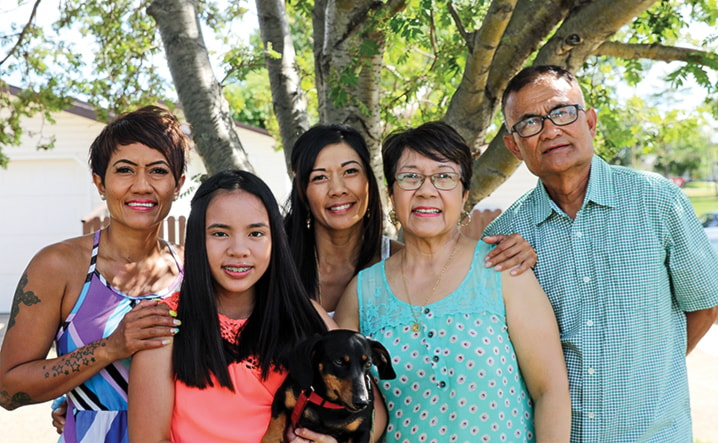It was 1970 when Jane Compton, a young Filipino, stepped off a plane in Winnipeg.
The 23-year-old didn’t have a job but she wanted to remain in Canada.
Despite being refused work as a garment worker, she persevered until she landed a job at the Gimli Community Hospital, which proved to be a game changer.
Compton met her future husband at the hospital and began her long career as a nurse in Canada.
For the next nine years, she worked at hospitals in Kapuskasing, Ont., Gander, Nfld., and Calgary, before landing in Red Deer for good in 1979.
Compton, now in her 60s, says she has few regrets about leaving the tropical Philippines for a new start in Canada.
“We came here because we wanted a better life,” said Compton, president of the Philippine Canadian Association of Red Deer and District. “It’s hard work back home. There is a reason why there are quite a few that come here. The money is good but at the same time it’s good to raise their families here.”
When Compton arrived here, the city’s population was under 40,000 and there were fewer than 200 Filipinos living in Red Deer.
But as Red Deer grew, so did its diversity.
The city’s 2015 census revealed Tagalog, the national language in the Philippines, tops the list of second languages in the city.
The last national census in 2011 revealed that the Filipino community is the largest expanding immigrant population in Canada. There are an estimated 662,600 people of Filipino descent living in Canada, according to the 2011 National Household Survey.
Compton is not surprised because she has seen the growth first-hand.
“In the 1970s, there were only 200 but of course those 200 started sponsoring their families,” she said.
In 1993, Ruben and Cora Virtucio moved to Red Deer from Davao, Philippines. Red Deer’s population was just under 60,000. They followed Cora’s parents and siblings
There were no Filipino stores or restaurants, so they were forced to buy Filipino food from a bootleg store in a woman’s house.
Cora said it was tough in the early days because they had few friends and there were few services for Filipinos. The recession in the 1990s made it challenging to find a job.
Now, as the city surpasses the 100,000 population mark, there are an estimated 3,000 Filipinos living and working in Red Deer. And that doesn’t take into account the growing numbers of Filipinos in surrounding communities such as Sylvan Lake, Ponoka or Lacombe.
There are Filipino-Canadians and temporary foreign workers in just about every field, but mainly the hospitality, home care and fast food industries.
Compton said there were once only six Filipinos at the Red Deer Regional Hospital Centre, where she continues to work today.
Now she sees her fellow Filipinos working in large numbers, as doctors, nurses, medical technicians and at other jobs.
“It’s almost like back home,” she laughed. “I see Filipinos wherever I go. I’m surprised because I used to know everyone. I know they belong to somebody. They are all friends of mine.”
She also noticed the churches in Red Deer began to add more services to accommodate the mostly-Catholic Filipinos.
More and more grocery stores are carrying Filipino food and supplies. There have also been a few restaurants and stores over the years.
Organizations like the Central Alberta Refugee Effort (CARE) offer services for newcomers to Central Alberta. It includes a partnership with the Red Deer Public Library, where a staffer helps newcomers.
Christina Wilson, library CEO, said the library boasts about 60 items — mainly print and aimed at children — written in Tagalog within its foreign language collection at the Dawe branch. Every year, the library adds to its collection.
Wilson said although there haven’t been many requests for Tagalog materials, they want to be proactive and stay ahead of the game. Last year, city council allocated $5,000 to the library to beef up its foreign language collection. The library will focus on adding materials in the Tagalog, Spanish, French, German and Mandarin languages. Among its materials, the library also offers Mango, a language-learning software package.
Ruben said they had a comfortable life in the Philippines but they moved to be closer with Cora’s family. Their three children are now all adults with families of their own.
Ruben worked at Olymel for 20 years before retiring in 2012 and Cora worked as a homecare worker at Michener for 19 years before retiring last year.
They said joining the Filipino association, where Ruben was president for a few years, helped them adjust to Canadian life. It also helped keep their culture alive in a foreign country. The Virtucios were part of the Filipino dance troupe for many years. They are happy to see their traditions stay alive in Red Deer.
The association promotes Filipino culture in the community while preserving the heritage through spring dances and celebrations. For more information and to learn about upcoming events, visit www.filipinoreddeer.org.
The Filipino dancers will perform during the Bower Pond Canada Day celebrations at 4:25 p.m.
crhyno@www.reddeeradvocate.com
